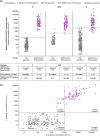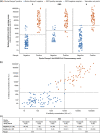Validation and performance of a multiplex serology assay to quantify antibody responses following SARS-CoV-2 infection or vaccination
- PMID: 35495877
- PMCID: PMC9040421
- DOI: 10.1002/cti2.1385
Validation and performance of a multiplex serology assay to quantify antibody responses following SARS-CoV-2 infection or vaccination
Abstract
Objectives: Robust, quantitative serology assays are required to accurately measure antibody levels following vaccination and natural infection. We present validation of a quantitative, multiplex, SARS-CoV-2, electrochemiluminescent (ECL) serology assay; show correlation with two established SARS-CoV-2 immunoassays; and present calibration results for two SARS-CoV-2 reference standards.
Methods: Precision, dilutional linearity, ruggedness, analytical sensitivity and specificity were evaluated. Clinical sensitivity and specificity were assessed using serum from prepandemic and SARS-CoV-2 polymerase chain reaction (PCR)-positive patient samples. Assay concordance to the established Roche Elecsys® Anti-SARS-CoV-2 immunoassay and a live-virus microneutralisation (MN) assay was evaluated.
Results: Standard curves demonstrated the assay can quantify SARS-CoV-2 antibody levels over a broad range. Assay precision (10.2-15.1% variability), dilutional linearity (≤ 1.16-fold bias per 10-fold increase in dilution), ruggedness (0.89-1.18 overall fold difference), relative accuracy (107-118%) and robust selectivity (102-104%) were demonstrated. Analytical sensitivity was 7, 13 and 7 arbitrary units mL-1 for SARS-CoV-2 spike (S), receptor-binding domain (RBD) and nucleocapsid (N) antigens, respectively. For all antigens, analytical specificity was > 90% and clinical specificity was 99.0%. Clinical sensitivities for S, RBD and N antigens were 100%, 98.8% and 84.9%, respectively. Comparison with the Elecsys® immunoassay showed ≥ 87.7% agreement and linear correlation (Pearson r of 0.85, P < 0.0001) relative to the MN assay. Conversion factors for the WHO International Standard and Meso Scale Discovery® Reference Standard are presented.
Conclusions: The multiplex SARS-CoV-2 ECL serology assay is suitable for efficient, reproducible measurement of antibodies to SARS-CoV-2 antigens in human sera, supporting its use in clinical trials and sero-epidemiology studies.
Keywords: COVID‐19; SARS‐CoV‐2; antibodies; electrochemiluminescence; immunoassay; serology.
© 2022 The Authors. Clinical & Translational Immunology published by John Wiley & Sons Australia, Ltd on behalf of Australian and New Zealand Society for Immunology, Inc.
Conflict of interest statement
DW, AAA, AR, KMT, MTE and EJK are employees of AstraZeneca and may hold stock or stock options. TG, RG, BF and CJBare employees of PPD® Laboratories and may hold stock or stock options.
Figures





References
LinkOut - more resources
Full Text Sources
Miscellaneous
